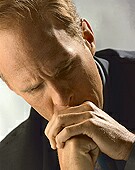 |
 |
 |

Mouse Study Finds Molecule That Tells Hair to Grow
Could one day lead to treatments for baldness, researchers say|
|
HealthDay
Thursday, July 31, 2008
 THURSDAY, July 31 (HealthDay News) -- Scientists have taken a step forward in understanding the mechanisms behind a problem that has bedeviled many men, and some women, for all of history: hair loss.
THURSDAY, July 31 (HealthDay News) -- Scientists have taken a step forward in understanding the mechanisms behind a problem that has bedeviled many men, and some women, for all of history: hair loss.
The study identifies a key signaling molecule that tells hair follicles to start the hair-growing cycle.
"These are very complex molecular signals, and the authors have very nicely shown that there is one molecule, laminins 511, that is a very important signal to tell the hair molecule to move through the process. It's part of a basic biological understanding," said Dr. Ronald Crystal, chairman of genetic medicine at New York Presbyterian Weill Cornell Medical Center in New York City.
The researchers, reporting in the Aug. 1 issue of Genes & Development, feel the findings may one day hold the key to treating male-pattern baldness, as well as hair loss from chemotherapy or even to restore hair on burn victims.
But, as so often happens, the study was conducted in mice and, as Crystal pointed out, "Mice are not just little men and women. They are different than us and also different in their hair."
A series of complex molecular signals tell hair follicles to go through a cycle of follicle growing, hair growing, follicle receding and hair receding, Crystal explained.
The same group of researchers had previously found that the protein laminin-511 was important to hair development.
In this study, the authors found out why. It was originally thought that laminin-511 was made from the cells of the outer layer of the skin (epithelium) and acted on the epithelium.
It now turns out, however, that the protein, although produced by the epithelium, actually penetrates into the inner layer of the skin (dermis) to kick start the hair-growing process.
"So laminin-511 is an early epithelial message to the dermis to say let's start producing hair," said study senior author Dr. Peter Marinkovich, an associate professor of dermatology at Stanford University School of Medicine and member of the Stanford Cancer Center. "Hair is formed as a result of cooperation and communication between the two layers."
"We knew that the two layers of the skin are important in hair formation, and we knew that there was some early epithelial signal hypothesized a long time ago, but no one knew what it was until now," he added.
In mice, laminin-511 convinced hair to grow at the equivalent of about the eighth month of pregnancy, but Marinkovich and his colleagues are hoping it might also work later in the life cycle.
Male baldness associated with aging would be an obvious target. "The hair follicles are still there, but they get stuck in the cycle, so it's not well understood why they're stuck and . . . how do you get them unstuck," Crystal said. "The hope, of course, is that you can apply this to humans, but there are some cautions in all that. Biology is very complex. There are a lot of checks and balances. You don't want hair follicles and cells in hair follicles to be growing too much or not enough. The on-and-off signals that are dampening that and controlling that are very, very complex and not well understood. This is far, far from humans."
HealthDay
Copyright (c) 2008 ScoutNews, LLC. All rights reserved.
Related News:
More News on this Date
Related MedlinePlus Pages:
| Home | Health Topics | Drugs & Supplements | Encyclopedia | Dictionary | News | Directories | Other Resources | |
| Disclaimers | Copyright | Privacy | Accessibility | Quality Guidelines U.S. National Library of Medicine, 8600 Rockville Pike, Bethesda, MD 20894 National Institutes of Health | Department of Health & Human Services |
Date last updated: 01 August 2008 |




